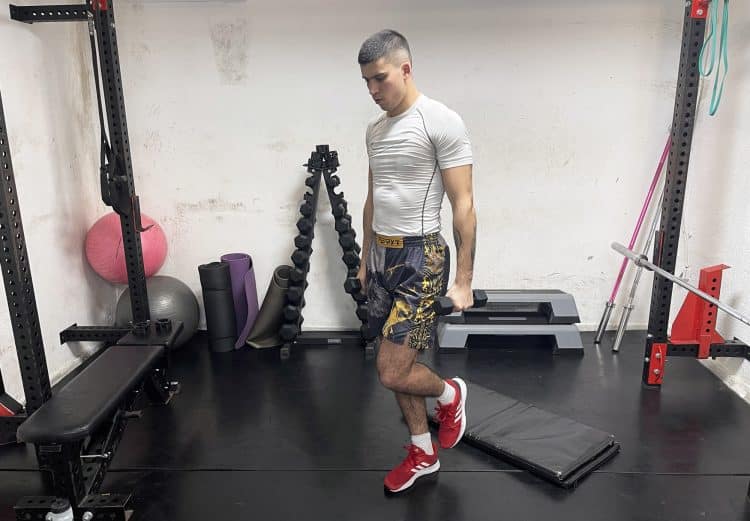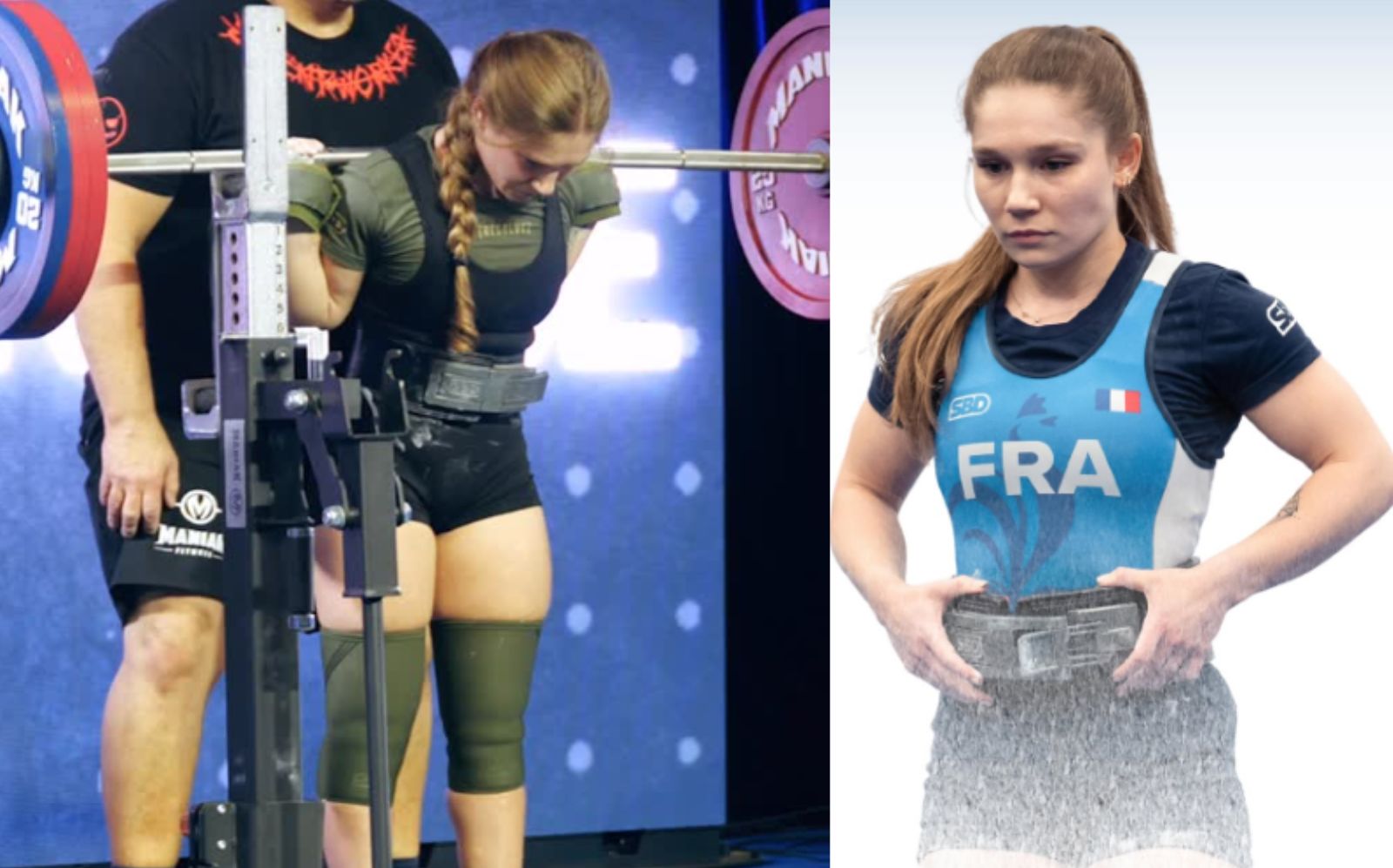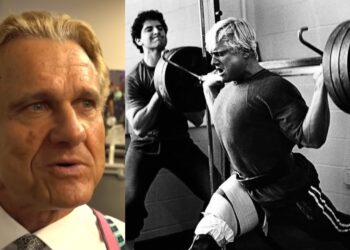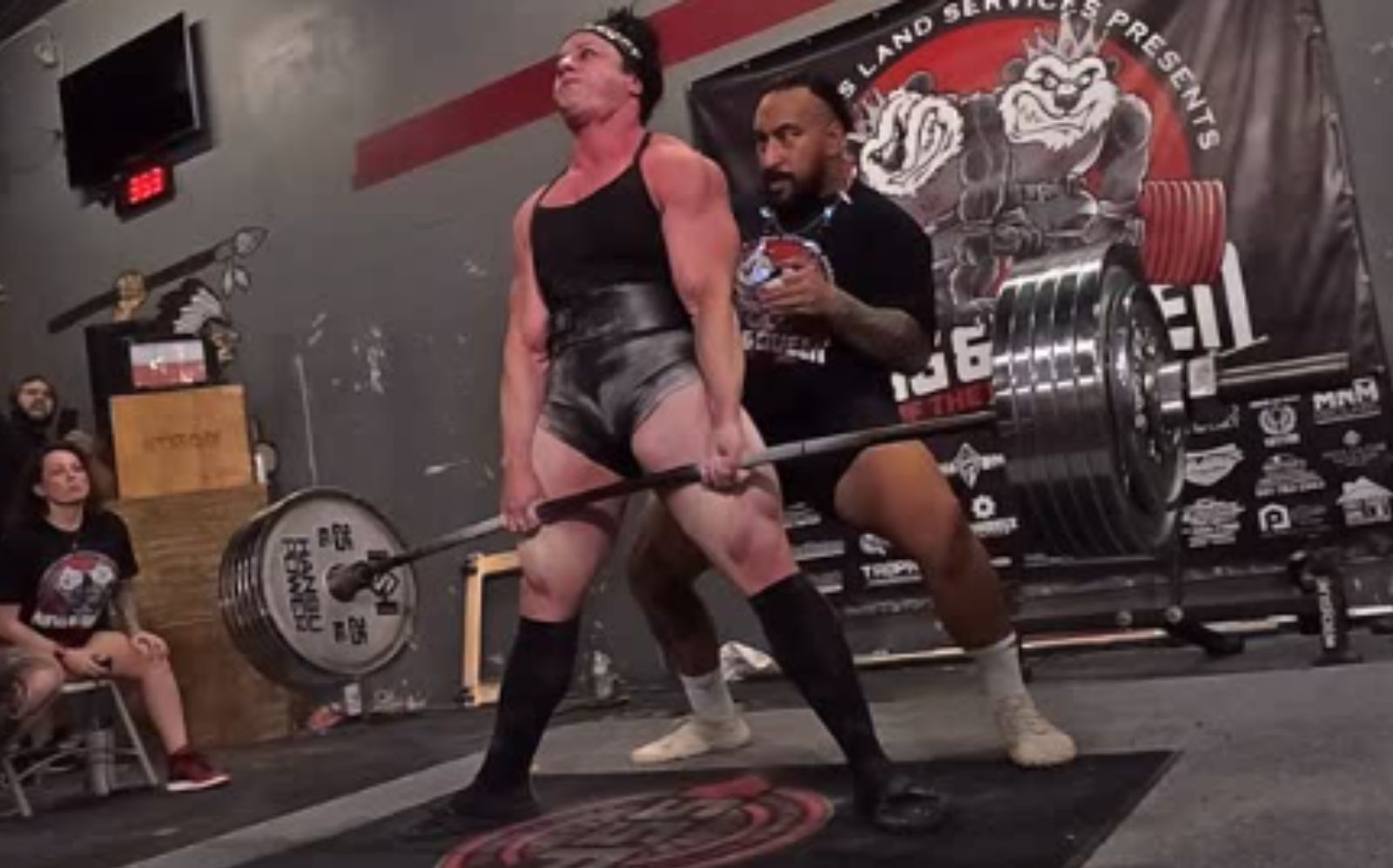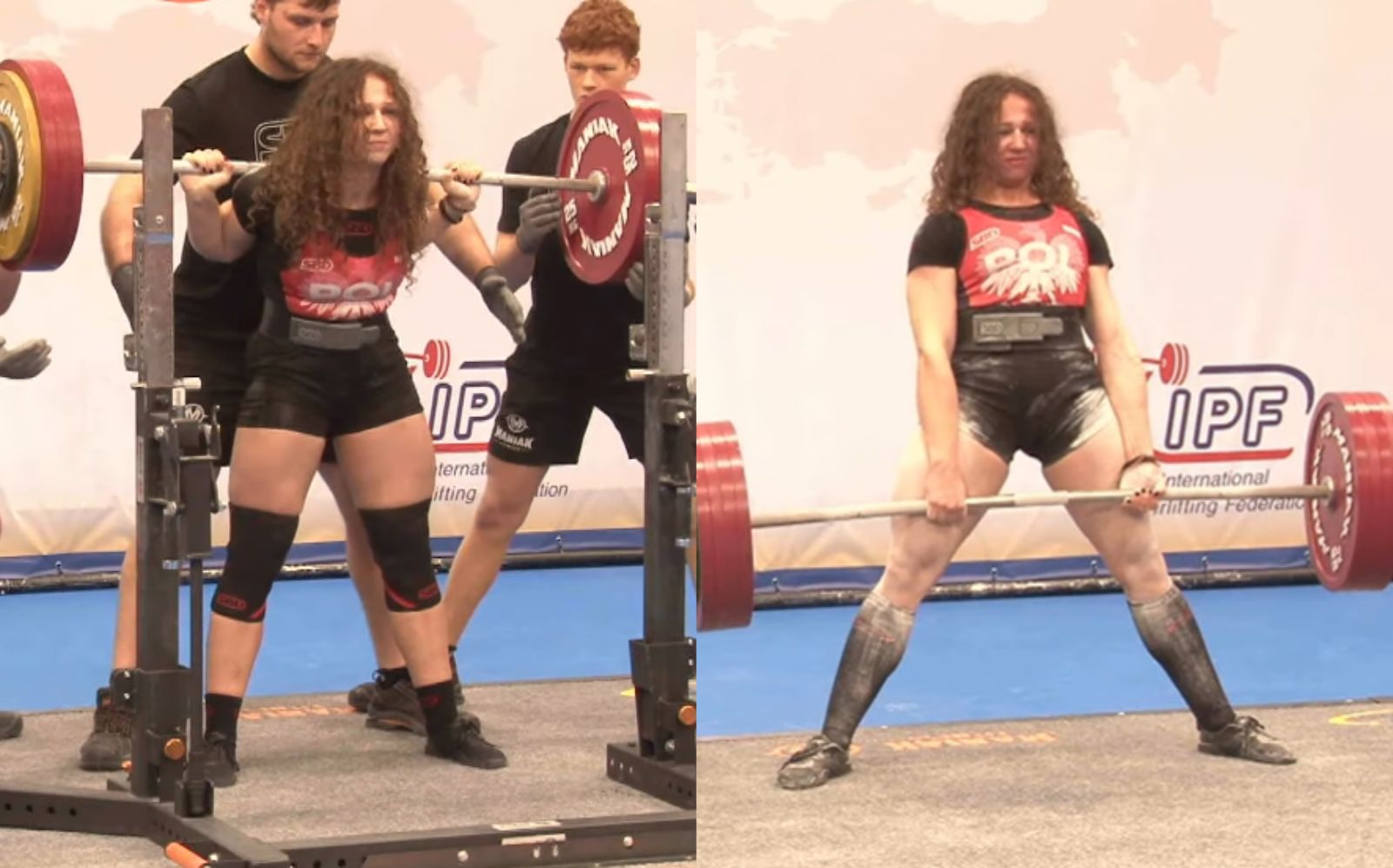If you’ve suffered countless ankle sprains like me and struggle to fully recover the lost range of motion (ROM), then you must try skater squats.
A study titled “Risk Factors for Lateral Ankle Sprains and Chronic Ankle Instability” found that the annual incidence rate of ankle sprains was 2.20 per 1,000 individuals for males and 2.10 per 1,000 individuals for females. (1)
However, lost ankle ROM isn’t the only reason you should perform skater squats. They also improve your lower body strength and challenge core balance and stability.
Besides that, skater squats are great at exposing flaws in your posture. These include genu varum (bow legs), genu valgum (knock-knees), lumbar rounding, core weakness, and passive foot mechanics.
Skater squats expose all of these flaws at once. This gives me a better picture of where to shift my focus to better serve my clients.
Below, I prepared a guide for performing skater squats, along with some tips, mistakes to avoid, and variations to include in your workouts.
Level Up Your Fitness: Join our 💪 strong community in Fitness Volt Newsletter. Get daily inspiration, expert-backed workouts, nutrition tips, the latest in strength sports, and the support you need to reach your goals. Subscribe for free!
What is Skater Squat?
A Skater Squat is a single-leg exercise that emphasizes balance, coordination, and strength in the lower body. To perform it, you start by standing on one leg, with the other leg extended behind you off the ground. As you maintain your balance, you bend the knee of the standing leg, lowering your body towards the ground in a controlled squat, while keeping the other leg extended. The motion is akin to a skater gliding on ice, hence the name. This exercise targets the quadriceps, hamstrings, and glutes of the supporting leg, as well as engages the core for stability.
The Skater Squat is particularly beneficial for those seeking to improve functional strength and balance. It mimics real-life movements and challenges, making it an ideal choice for athletes and fitness enthusiasts alike. Additionally, this exercise can be modified to suit different fitness levels by adjusting the squat depth or adding weights for increased resistance.
How To Perform Skater Squats
Here is how to perform skater squats properly.
Step One — Assume the Starting Position
Stand upright with your feet hip-width apart. Place an exercise mat behind you. Slightly bend your right knee. Lift the left foot off the floor by flexing your left knee so your upper and lower legs are at 90 degrees. Keep your hands on your sides. Ensure your back is straight.
Pro Tip: Contract your core muscles for optimal stability in the starting position. Advanced lifters can perform this exercise while holding a dumbbell in each hand.
Step Two — Lower Your Knee to the Floor
Lower your left knee onto the pad as you extend your arms in front of you. Ensure your back is straight throughout the eccentric phase. Hold the bottom position for one second. Don’t rest your left knee on the pad; just slightly touch it without placing the whole weight on the ground.
Pro Tip: Controlled movement is key here. Slowly lower towards the floor and aim to keep your body stable throughout the whole range of motion. This will increase the time under tension (TUT), improve your mind-muscle connection, and fire up your stabilizers.
Step Three — Return to the Starting Position
Reverse the motion by extending your working leg to return to the starting position. As you come up, lower your hands to your sides.
Pro Tip: Visualize pushing the floor away with your right foot. This will force you to activate more muscle fibers than usual, helping you to return to the starting position.
Muscles Worked with Skater Squats
Based on my biomechanical analysis, here are the primary muscles working during skater squats:
- Gluteus maximus
- Quadriceps
- Hamstrings
- Adductors
Also, here are the secondary muscles worked:
- Core musculature
- Calves
- Hip abductors
- Erector spinae
Tips For Skater Squats
Here are some tips for performing skater squats:
Start with a Warm-up
Always properly warm up your body before performing skater squats.
Raise your body’s core temperature first with light cardio. Then, perform some dynamic warm-ups. Lastly, finish with some hip bridges and bodyweight single-leg deadlifts to ensure all muscles are primed. This will significantly reduce the chance of injury while maximizing your exercise performance.
Focus on Balance
Make sure to focus most of your attention on keeping your body balanced throughout the movement. Focus on contracting your core and hip musculature, which will help keep your body stable.
Controlled Movement
Perform skater squats with controlled movement to reduce the chance of injury. However, this will also increase time under tension, which is crucial for muscle hypertrophy and improving mind-muscle connection.
As you get better and more experienced with skater squats, perform the concentric phase as fast as possible. This will enable you to develop more unilateral leg strength and power while ensuring you fire up most of your fast-twitch muscle fibers.
Breathe Properly
Pay attention to your breathing as you perform skater squats. Inhale during eccentrics. As you ascend, exhale sharply. One thing that helped me immensely during the concentric phase was incorporating abdominal breathing.
Level Up Your Fitness: Join our 💪 strong community in Fitness Volt Newsletter. Get daily inspiration, expert-backed workouts, nutrition tips, the latest in strength sports, and the support you need to reach your goals. Subscribe for free!
To achieve this, exhale forcefully from your diaphragm while actively engaging your abdominal muscles. This rapid exhalation, aided by abdominal muscle activation, will assist you in ascending with greater speed and ease.
Most Common Mistakes to Avoid During Skater Squats
The most common mistakes to avoid when doing skater squats include poor balance and stability, improper foot placement, rounding the back, not engaging the core, neglecting to use arms for balance, and ignoring unilateral discrepancies.
Let’s cover each of these briefly below.
Poor Balance and Stability
You can’t effectively perform skater squats if you have poor balance and stability. However, I am not saying you avoid performing this exercise because you lack balance and stability.
I’m emphasizing the significance of engaging your core muscles, which are vital for maintaining stability.
Improper Foot Placement
While performing skater squats, the foot of your working leg must be planted firmly on the ground. Mistakes here usually include lifting your heels and shifting your body weight laterally, which causes instability. Ensure your working foot is firmly placed on the ground and remains stable throughout the entire exercise.
Rounding the Back
Rounding your entire back, usually upper but sometimes lower as well, is a big mistake. Generally, this happens because you are trying to compensate for bad mobility or weak stabilizer muscles.
To avoid this, perform a series of hip and leg mobility exercises before doing skater squats. Also, activate your core during the exercise to prevent spinal movement.
Not Engaging the Core
Not engaging your core is a mistake that will hamper your stability and balance during the exercise.
Actively engaging the core and entire abdominal musculature will result in better trunk and lower body stability.
Neglecting To Use Arms For Balance
Neglecting to use arms for balance will make the entire exercise much harder. Extending your arms in front of you is a great way to counterbalance. It will improve stability and enable you to perform skater squats with better control. Better balance allows you to put more emphasis on your technique and form.
Ignoring Unilateral Discrepancies
Most of us have one limb that is stronger than the other. This is completely normal, as people have dominant and non-dominant sides. It is also because of lateralization, a tendency for certain functions or activities to be more specialized to one side of the body. (2)
However, this doesn’t mean you should neglect one side or limb. To minimize muscle imbalances, I suggest the following:
At the beginning of each set of a unilateral exercise, perform the movement with your weaker side. This is because the freshness of your central nervous system (CNS) is one of the factors that can impact your performance.
Another recommendation is to determine the number of reps with a specific load based on the repetitions you can perform with your weaker limb.
Over time, you’ll observe a gradual reduction in muscle imbalances in terms of strength, although they may never completely vanish.
Skater Squats Variations
Here are some of the best skater squats variations to include in your workouts:
Assisted Skater Squat
Assisted skater squats are a regressive exercise that will help those who lack balance and stability.
Steps:
- Assume a standing starting position with your feet hip-width apart.
- Place a pad behind you.
- Place a chair or some other object for support in front of you.
- Slightly bend your right knee.
- Lift the left foot off the floor by fully flexing your knee.
- Keep your hands on the chair for support.
- Ensure your back is straight.
- Lower your left knee towards the pad.
- Hold the bottom position for one second.
- Reverse the motion to the starting position.
- Repeat for the desired amount of reps.
Pro Tip: Use only light assistance using your hands and gradually reduce the reliance. This will build strength and coordination in your working leg so you can proceed with the non-assisted skater squat variation.
Pulse Skater Squat
Pule skater squats are excellent for increasing time under tension and biasing the glutes and quads.
Steps:
- Assume a standing position with your feet hip-width apart.
- Place a pad behind you.
- Slightly bend your right knee.
- Lift the left foot off the floor by flexing your left knee.
- Keep your hands on your sides.
- Simultaneously lower your left knee towards the pad as you extend your hands in front of you to counterbalance.
- Perform small pulses at the bottom of the movement.
- Reverse the movement to return to the starting position.
- Repeat for the desired amount of reps.
Pro Tip: Concentrate on maintaining a consistent, small up-and-down movement in the lower half of the range of motion. This will intensify the burn and maximize muscle engagement, especially in the glutes and quads.
Wrapping Up
Skater squats are phenomenal for challenging your stability and balance. In my experience, they were particularly useful because they require a lower range of motion in the ankle, and I have had many ankle injuries. Some tips I would like you to remember include warming up, focusing on your balance, controlling the movement, and breathing properly.
In addition, avoid mistakes such as poor balance and stability, improper foot placement, rounding your back, and failing to engage your core. In the comments below, let me know your thoughts on skater squats and how you implement them in your workouts.
References
- Delahunt E, Remus A. Risk Factors for Lateral Ankle Sprains and Chronic Ankle Instability. J Athl Train. 2019;54(6):611-616. doi:10.4085/1062-6050-44-18
- Rogers LJ. Brain Lateralization and Cognitive Capacity. Animals (Basel). 2021;11(7):1996. Published 2021 Jul 3. doi:10.3390/ani11071996
Relevant Articles:
- How To Do Shrimp Squat Exercise
- The 8 Most Common Squat Mistakes and How to Fix Them
- How to Do Kang Squat
Interested in measuring your progress? Check out our strength standards for Deadlift, Squat, Single Leg Deadlift.



